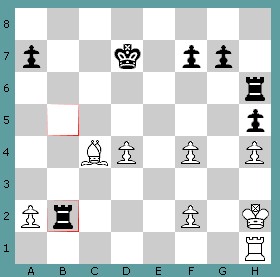
STANLEY RANDOM CHESS MONTHLY

Studies of the ancient Roman historian Livy (Titus Livius) have concluded that Livy included coded references to Stanley Random Chess in his work, with particular mention of the Saragossa position. This article contains an introduction to this famous draw position, and provides citations from Livy which appear to make mention of it.
A recent game between two amateurs concluded with the famous Saragossa draw position. Here's the game:

|
| 34...Rxb2 |
It's gratifying to see an instance of the Saragossa draw position, since it's a very difficult position to arrive at under VH Conditions. As those familiar with Leopold Strauss' text A Reexamination of Forced Inferior Material Resignations: A Guide to Winning Play under VollenHauser Conditions (Belgrade Press, 1934) will know, the Saragossa draw position was pioneered during a friendly game between St. Vincent of Saragossa and St. Valerius of Saragossa in 303AD. With a strong material advantage, Valerius was clearly favored to win under VH Conditions, but a strange turn of events led to the novel draw.
Under investigation for heresy by Emperor Diocletian, both players were forced to create a mutual indeterminate stalemate position (3rd level finite retraction) with the white bishop on c4 in order to protect their own lives. After consulting with the Bishop of Saragossa, the poet Prudentius, who was officiating, declared a indeterminate draw, and none of Diocletian's soldiers were able to refute it. Although it is not widely known, even in SRC circles, contemporary Catholic bishops entrenched in freemasonry still use the position today as a defence against charges of ecclesiastical heresy, by wearing a white gown upside down, and declaring "See Four!" (a clear reference to the bishop's egocentric position on c4), usually recited in Gregorian chant by the four monks in attendance.
Of related interest, is the fact that the historical accounts concerning Vincent and Valerius appear to document early instances of the Great SR Chess purge, as is evidenced by the clear bias in their descriptions of the SRC cantors, making no reference whatsoever to the striped socks, melted candle-wax, or mandatory player-gourds.
The subject is still being studied by scholars at a university in Rome, but evidence is mounting that Latin manuscripts from the ancient Roman historian Livy (Titus Livius) contain coded references to Stanley Random Chess. As part of Livy's narration concerning the conquest of Greece and of the East, there is the famous line:
Livy's deliberate choice of the Latin word "provideo" is of great significance, the word literally meaning "I foresee". Recent etymological studies give overwhelming proof that only one explanation is possible for the unusual choice of the word "provideo" or "I foresee" in this context: it must be a cryptically reversed rendition of the "See Four" uttered by the four monks at the legendary SR Chess game in question at Saragossa. It appears certain that Livy was familiar with the Saragossa draw position, with its mandatory positional bishop on c4, but was compelled to allude to it secretly in order to avoid charges of heresy. Despite the repression of the Great SR Chess Purge, Livy was trying to preserve some reference to SR Chess for posterity. If this startling thesis proves true, then the Saragossa draw position will prove to be of much greater historical significance to the game than has long been thought.
The studies also cite evidence from anthropological research published in 1962, documenting the cultural life of an ascetic and reclusive monastic order in the hills near Rome. The monks were said to play an obscure variation of chess, which was concluded with the singing of "Iam provideo animo" in Gregorian chant, usually performed by a quartet of visiting nuns. In the absence of nuns, bearded peasants were shaven and recruited to dress as nuns for this purpose in groups of four, a tradition to which we owe our modern "barbershop quartet." A definitive link between barbershop quartets and SR Chess has long been suspected, and the supporting historical evidence demanded by critical scholarship is now in place.
In a remarkable coincidence, the research is being sponsored in part by corporate support of the Provideo Home Theatre company (based in Washington DC). The company CEO denies any interest in chess, stating his hobbies are exclusively limited to basket-weaving, French knitting, and egg-planting.
For further reading, see also the article On Draws in Stanley Random Chess.
SR Chess GM Gregory Topov
Posted Tuesday - 2006-04-04 - 12:07:25 EST
by Staff Reporter Verdra H. Ciretop in Toronto
All Rights Unreserved - Loof Lirpa Publishing
Text may be freely copied & redistributed